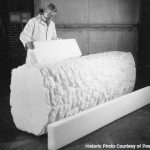The History Of Styrofaom
The history of Styrofoam dates back to 1941, researchers in Dow’s Chemical Physics Lab found a way to make foamed polystyrene. Led by Ray McIntire, they “rediscovered” a method first discovered by Swedish inventor Carl Georg Munters. Dow acquired exclusive rights to use Munters’ patents and found ways to make large quantities of extruded polystyrene as a closed cell foam that resists moisture.
In the United States and Canada, the word Styrofoam refers to expanded (not extruded) polystyrene foam, such as disposable coffee cups, coolers, or cushioning material in packaging, which are typically white and are made of expanded polystyrene beads. This is a different material from the extruded polystyrene used for Styrofoam insulation. The polystyrene foam used for craft applications, which can be identified by its roughness and by the fact that it “crunches” when cut, is moderately soluble in many organic solvents, cyanoacrylate, and the propellants and solvents of spray paint, and is not specifically identified as expanded or extruded. Another tradename for expanded polystyrene is thermacol, originated by BASF

History of Styrofoam
styro Foam
